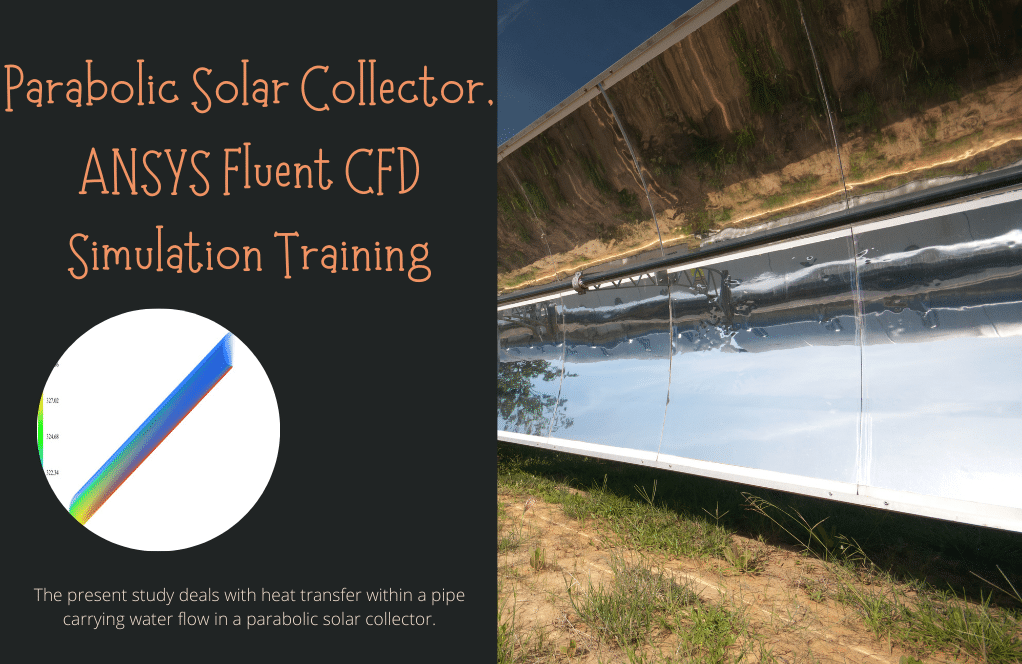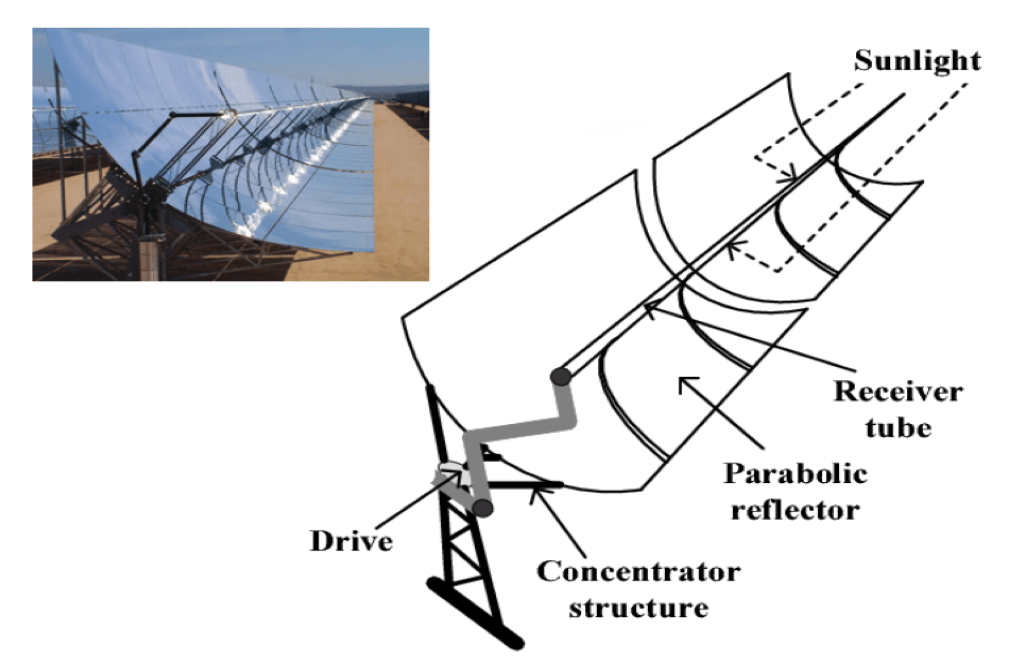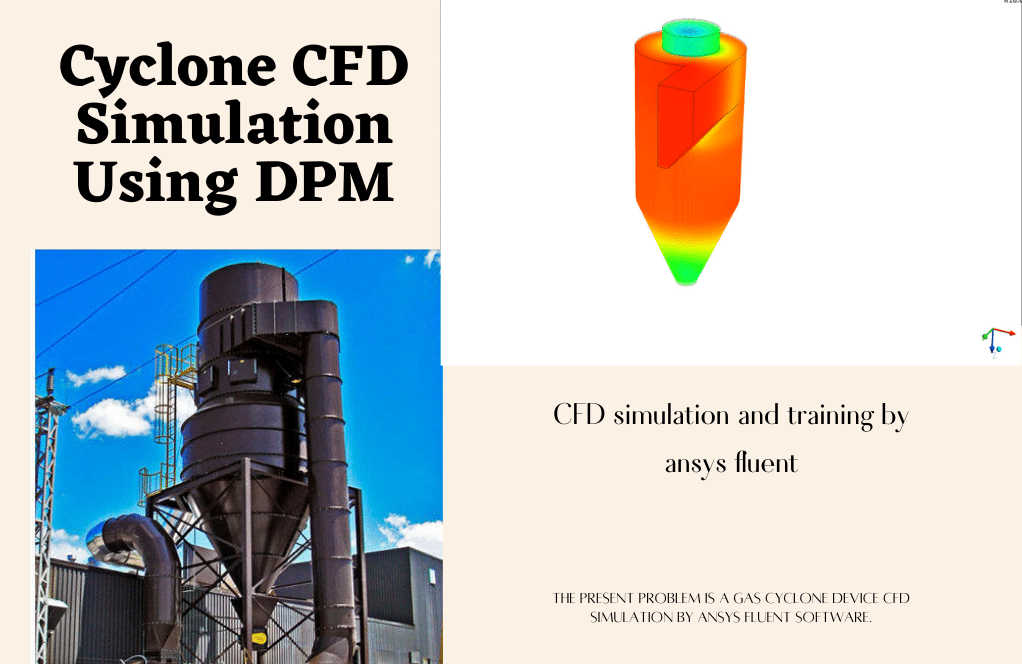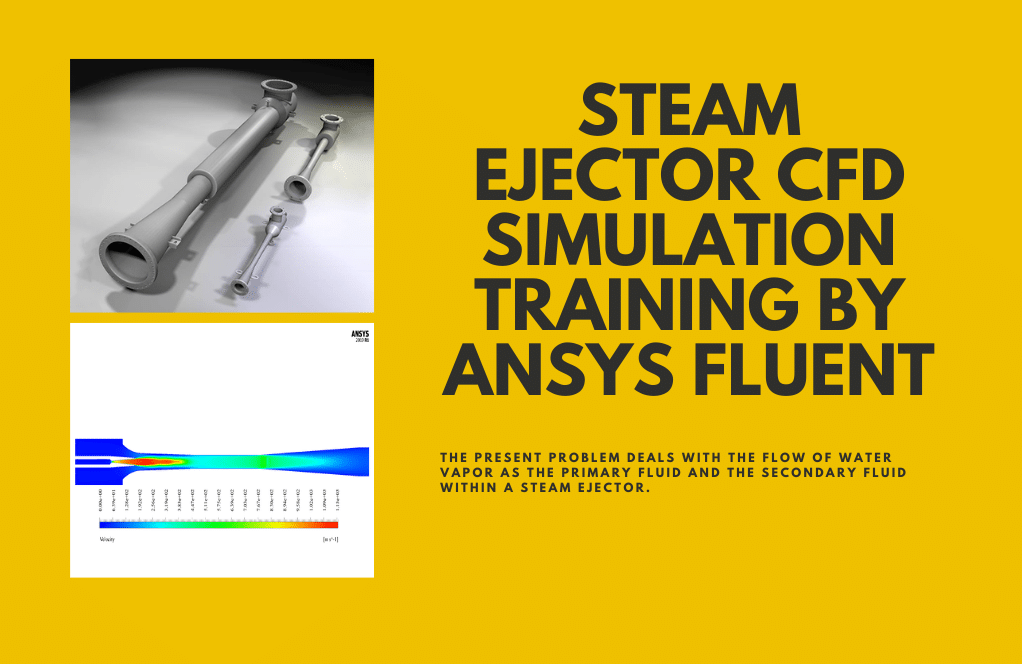Parabolic Solar Collector, ANSYS Fluent CFD Simulation Tutorial
$80.00 Student Discount
- The problem numerically simulates the Parabolic Solar Collector using ANSYS Fluent software.
- We design the 3-D model by the Design Modeler software.
- We Mesh the model by ANSYS Meshing software, and the element number equals 1475000.
- We use thermal boundary conditions to apply the radiation effect.
To Order Your Project or benefit from a CFD consultation, contact our experts via email ([email protected]), online support tab, or WhatsApp at +44 7443 197273.
There are some Free Products to check our service quality.
If you want the training video in another language instead of English, ask it via [email protected] after you buy the product.
Description
Description
This simulation is about parabolic solar collectors via ANSYS Fluent software. We perform this CFD project and investigate it by CFD analysis.
The present study deals with heat transfer within a pipe carrying water flow in a parabolic solar collector. In the present model, a water-flow pipe is exposed to solar radiation.
Behind the tube is a parabolic plate as the solar radiation absorber plate, which is responsible for absorbing the solar radiation energy and then reflecting it. This is the mechanism of a parabolic solar collector.
In this case, only a water flow pipe is modeled, such that the water pipe wall is divided into two upper and lower wall sections. The upper part of the wall is directly exposed to solar energy.
In contrast, the lower part of the wall is influenced by reflective energy from the parabolic absorber plates of the collector. Two different constant heat fluxes were applied on two walls. The tube wall is made of aluminum.
The geometry of the present model is drawn by Design Modeler software. This geometry is a semi-cylindrical tube since the model is symmetry. The tube consists of two layers, the thin outer layer acting as the tube wall and the inner portion as the fluid domain.
The model is then meshed by ANSYS Meshing software. The model mesh is unstructured, and 1475000 cells have been created.
Solar Collector Method
In this simulation, the energy model is activated because the main goal of this project is heat transfer. The radiation model can be used to model the current solar collector.
However, in this project, it is assumed that we have the amount of heat from the radiation to simplify the modeling process. Therefore, we use the collector walls’ constant heat flux boundary condition.
Solar Collector Result
After simulation, the contours of temperature, velocity, and pressure are obtained. The temperature contour shows that the heat from the solar radiation (constant heat flux) affects the water flow pipe inside the collector.
This effect causes the temperature of the water flowing inside the pipe to rise. In this way, the collector system works properly.






Thea Bechtelar –
How does this simulation model the solar radiation?
MR CFD Support –
The simulation uses the Discrete Ordinates (DO) radiation model to simulate solar radiation accurately. This model considers the directional effects of radiation, making it suitable for solar collector simulations.
Haylie Ebert –
How does the simulation model the heat transfer in the receiver tube?
MR CFD Support –
The simulation uses the energy equation to model the heat transfer in the receiver tube. This equation takes into account conduction, convection, and radiation, providing a comprehensive description of the heat transfer process.
Mrs. Jody Auer III –
What are the advantages of using a parabolic solar collector?
MR CFD Support –
Parabolic solar collectors offer several advantages, including high efficiency, the ability to reach high temperatures, and the potential for direct generation of steam. They are particularly suitable for applications requiring high heat levels, such as industrial process heat and power generation.
Leonor Gislason –
The tutorial was insightful. Seeing the temperature rise in simulation was like watching the solar collector come to life. Great job!
MR CFD Support –
Thank you for your kind words. We’re thrilled to hear that the simulation brought the solar collector’s functionality to life for you. Feedback like yours motivates us to continue creating valuable, engaging tutorials!
Willa Bashirian –
I’m delighted with how the simulation handles the heat transfer in the parabolic solar collector. It offers a practical perspective on the working of these collectors. Big applause to the team for creating such an effective educational tool!
MR CFD Support –
Thank you for your positive feedback! We’re thrilled to hear that the parabolic solar collector simulation met your expectations and provided you with valuable insights into heat transfer. It’s always our goal to deliver effective and practical learning tools. If you have any more insights or need further assistance, feel free to reach out!
Merritt Hudson –
The tutorial on the Parabolic Solar Collector was clearly structured and thorough. I was able to follow the steps with ease and replicate the research example in my simulation. Particularly handy was the section separating the tube wall into two parts to model the different heat flux regions, effectively showing how the collector harnesses the solar energy. Hats off to MR CFD Company for crafting such an understandable and comprehensive CFD tutorial!
MR CFD Support –
Thank you very much for your kind words! We’re thrilled to hear you found the Parabolic Solar Collector simulation tutorial clear and useful. Your success in replicating the simulation and appreciating the method of separating the dome into different regions for heat flux simulation tells us that our efforts to make these tutorials comprehensive are paying off. Thank you for choosing MR CFD Company as your CFD learning resource!
Vilma Cormier –
I just completed the tutorial on parabolic solar collectors using ANSYS Fluent, and I’m very pleased with how well-explained the radiation models and boundary conditions were.
MR CFD Support –
Thank you for your positive feedback! We’re delighted to hear that our tutorial on parabolic solar collectors was helpful and that you found the explanation on radiation models and boundary conditions clear and informative.
Elinore Toy –
I’ve learned so much from your tutorial! I was intrigued by the effectiveness of the parabolic solar collector in heating the water. Great job at explaining the complex concepts in an understandable way!
MR CFD Support –
Thank you for your kind words. We are thrilled to hear that you found our parabolic solar collector tutorial informative and understandable. We always strive to simplify complex concepts and make learning as accessible as possible. Don’t hesitate to reach out if you have any more questions or need further assistance!
Mrs. Sandy Greenfelder I –
I was thrilled to see how you modeled the water flow pipe and the parabolic plate effectively. I can understand the complex concepts much better through your visual aids and clear explanations.
MR CFD Support –
Thank you so much for your kind words. We are pleased to hear that you found the tutorial both effective and helpful in understanding the complex concepts of a parabolic solar collector simulation. It’s always encouraging for us to hear about positive experiences with our educational materials. If you have any more questions or need further assistance, feel free to reach out.
Dr. Anabel Cummerata –
Can this simulation predict the efficiency of the solar collector?
MR CFD Support –
Yes, the simulation provides insights into the temperature distribution and heat transfer rates, which can be used to calculate the efficiency of the solar collector.
Peter Dietrich –
I’ve learned a ton from this tutorial on parabolic solar collectors! The explanation regarding the reflective energy and the division of the tube into two wall sections was really insightful. It was also interesting to see how just applying constant heat fluxes could effectively simulate the heat transfer process without complicating the project with radiation modeling — clever and time-saving!
MR CFD Support –
Thank you for sharing your positive experience with our parabolic solar collector simulation tutorial. We are glad to hear that the simplification made the learning process efficient and that you could understand the heat transfer mechanism within the solar collector system. Your feedback is much appreciated, and we hope you continue to find value in our products!
Arthur Yost –
I am impressed with the way the parabolic solar collector simulation handles heat transfer within the pipe. The attention to detail, from the materials used for the walls to the accurate application of heat fluxes, shows how realistic these simulations can be!
MR CFD Support –
Thank you for your positive feedback! We are delighted to know that the attention to detail in our parabolic solar collector simulation met your expectations and was able to provide a thorough and realistic insight into the heat transfer process. It’s great to hear our CFD product could impress you. If you have any thoughts about how we can make it even better, feel free to share them with us!
Rickey Ziemann –
I’m impressed with how well the solar collector simulation reflects real-world heat transfer. The distinction between energy absorbed directly and energy reflected from the parabolic plates is intriguing!
MR CFD Support –
Thank you for your positive review! We’re thrilled to hear that our simulation has provided a clear representation of heat transfer in a parabolic solar collector. Your understanding and appreciation of the detailed energy absorption and reflection mechanism are much appreciated!
Dr. Ashtyn Watsica –
The tutorial was incredibly helpful for understanding the heat transfer process in a parabolic solar collector. The step-by-step approach made the CFD setup seem less daunting and really highlighted the important aspects of this kind of simulation.
MR CFD Support –
Thank you for your positive feedback! We’re really glad to hear that our Parabolic Solar Collector simulation tutorial was clear and useful to you. If you need further assistance or have more interest in solar energy simulations, feel free to explore our other learning materials!
Dejuan Grant –
I’m impressed by the sophistication of the model! Can you tell me more about how the constant heat flux was determined for the two different wall sections?
MR CFD Support –
In the simulation model, the constant heat flux applied to the two wall sections is an assumption. We calculate the heat flux based on the intensity of solar radiation incident on the collector and the reflectivity of the parabolic plates. This takes into account the energy absorbed and reflected by the system. Detailed calculations or empirical data are generally used to define these heat flux values in order to closely mimic the actual solar radiation captured by the parabolic solar collector.
Alanna Beatty –
Just wanted to express my gratitude for this comprehensive ANSYS Fluent tutorial on the parabolic solar collector. The level of detail covered in heat transfer and the use of constant heat flux to model the efficiency of the collector is impressive. The tutorial guided me through each step, from geometry design to meshing and simulation results. Seeing the temperature contours and how they reflect the collector’s performance gave me a real feel for how these systems work in practice.
MR CFD Support –
Thank you for your kind words! We are delighted to hear that our tutorial on parabolic solar collectors was detailed and helpful to you. It’s great to know that the step-by-step guidance was comprehensive and that the simulation results offered valuable insights into the functionality of solar collectors. If you have any further questions or seek more tutorials, feel free to contact us.
Rickie Miller –
I just finished the Parabolic Solar Collector tutorial, and I was blown away by how well-explained everything was. I now have a much deeper understanding of how to set up and solve heat transfer problems involving solar radiation. The way the constant heat flux was applied to simulate solar absorption and reflection was particularly eye-opening!
MR CFD Support –
Thank you for your kind words! We’re delighted to hear that the tutorial provided clarity and depth on handling heat transfer in solar collectors. Your understanding of applying constant heat flux as a surrogate for actual solar radiation is spot on. Should you ever have any questions or need further assistance with similar simulations, feel free to contact us!
Vivianne Schneider –
The tutorial was concise and made the concept of heat transfer in the solar collector clear. The use of heat flux boundary conditions instead of a complex radiation model smartly simplified the simulation.
MR CFD Support –
Thank you for your positive feedback! We’re glad that the tutorial was helpful for you and that you appreciated the simplicity in modeling the solar collector. We always strive to create content that is both informative and accessible. If there is anything else we can help with or explain further, don’t hesitate to reach out.
Mohamed Carter –
How does the simulation handle the reflection of solar radiation by the parabolic collector?
MR CFD Support –
Response: The simulation uses the specular reflection boundary condition to model the reflection of solar radiation by the parabolic collector. This condition assumes that the radiation is reflected in a single direction, like a mirror.
Dr. Dwight Casper –
I’m really pleased with how accurately the simulation captured the effects of heat transfer in the parabolic solar collector. The visualizations of temperature and velocity helped me understand the efficiency of the collector. Great tutorial!
MR CFD Support –
We’re thrilled to hear that the tutorial helped deepen your understanding of heat transfer within a parabolic solar collector, and that you found our visualizations effective. Thank you for your appreciative words; it encourages us to keep delivering high-quality content!
Mrs. Marisol Shields I –
I just finished the parabolic solar collector tutorial, and it was fantastic! Everything was explained perfectly, and now I feel confident about simulating my own designs. The step-by-step approach really made complex concepts easier to grasp.
MR CFD Support –
Thank you very much for your kind words! We’re thrilled to hear that the tutorial was helpful and that you now feel confident in applying what you’ve learned. If you ever have more questions or need further assistance with your designs, remember that we’re here to help. Don’t hesitate to reach out. Good luck with your simulations!
Rosalind Emmerich –
I appreciate how the parabolic solar collector simulation incorporates heat transfer and the effect of solar radiation. The technical aspects of the model setup, especially the use of constant heat flux boundary conditions to simulate solar radiation, made the CFD study very informative.
MR CFD Support –
Thank you for your positive feedback! We’re glad to hear that you found the parabolic solar collector simulation insightful and that the setup details provided a clear understanding of how solar radiation impacts heat transfer in the system. Your appreciation encourages us to continue delivering high-quality and informative simulations. If you have any more questions or need further assistance, please feel free to reach out.
Karen Feest –
I was impressed with how the temperature of the water increased due to the heat from solar radiation. It was fascinating to see how effectively the parabolic solar collector works!
MR CFD Support –
Thank you for your positive feedback. We’re thrilled to hear that our simulation was successful in demonstrating the efficiency of a parabolic solar collector. It is our goal to provide clear and educational simulations that help our users understand the principles at work in these systems, and we’re glad that you found it fascinating!
Lorenza West –
Your CFD project on the parabolic solar collector was incredibly enlightening. The approach to apply constant heat fluxes to represent solar radiation was clever and practical. Great job!
MR CFD Support –
Thank you so much for your kind words and positive feedback on our Parabolic Solar Collector simulation tutorial. We are thrilled to hear that our approach to simplifying the modeling process met your expectations and provided you with an informative and enlightening experience. Your satisfaction is our top priority, and we are pleased that the tutorial was beneficial for you. If you ever have more questions or need further assistance, please feel free to reach out. Thank you for choosing MR CFD for your learning needs!
Daron Parker Jr. –
The tutorial on Parabolic Solar Collector simulation is reflective of the dedicated effort in demonstrating intricate thermal processes. Bravo to the team for articulating the intricate heat transfer dynamics and providing clear visualization through temperature contouring.
MR CFD Support –
Thank you so much for the kind words! We’re thrilled to hear that you found the tutorial on the Parabolic Solar Collector simulation helpful and informative. Understanding heat transfer in such applications is critical, and we’re glad we could assist in clarifying these concepts. We appreciate your feedback!
Ms. Zula Upton –
I’ve gone through various simulations, and this one stands out. I’m very impressed with the thoroughness of capturing the physics of a solar collector. The consideration of different constant heat fluxes on the upper and lower walls is an excellent touch that lends realism to the simulation. Fantastic!
MR CFD Support –
We’re thrilled to know that you appreciate the detail and accuracy of the parabolic solar collector simulation. Our team strives to create simulations that not only demonstrate the application of CFD principles but also closely resemble real-world processes. Thank you for your kind words and for recognizing our efforts!
Stephania Yundt –
I’ve been impressed with the clarity of the tutorial for the parabolic solar collector simulation in ANSYS Fluent. It provided a comprehensive understanding of the setup and results analysis. The step-by-step guidance on applying boundary conditions and reviewing the temperature and velocity contours is greatly appreciated.
MR CFD Support –
Thank you for the kind words and positive feedback about the parabolic solar collector tutorial! We’re thrilled to hear that you found it clear and comprehensive. It’s great to know that the guidelines provided were helpful to you. We constantly strive to create valuable and understandable content for our users. Should you have any further queries or require additional information on any simulations, please don’t hesitate to contact us.
Raymundo Brakus DVM –
I’m really impressed by how the parabolic solar collector simulation could provide temperature, velocity, and pressure contours. This surely is a great learning tool for understanding thermal systems.
MR CFD Support –
We’re thrilled to hear that you found the simulation on the parabolic solar collector informative and helpful. It’s wonderful to know that our products are serving their purpose in enhancing understanding of thermal systems. Thank you for taking the time to share your positive feedback!
Mr. Laverne Lesch I –
This tutorial sounds impressive! Your description shows how well-designed the simulation is. The various elements from using even heat fluxes as a simplification, to the application of the energy model, demonstrate careful thought in crafting a meaningful and educational CFD project.
MR CFD Support –
Thank you for your positive feedback! We’re delighted to hear that you found the tutorial on the parabolic solar collector simulation using ANSYS Fluent to be informative and well-structured. We strive to provide high-quality learning material and it’s great to know that our efforts are appreciated.